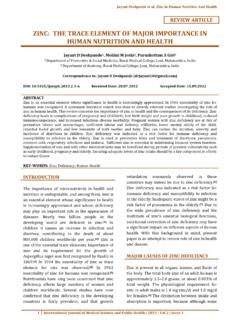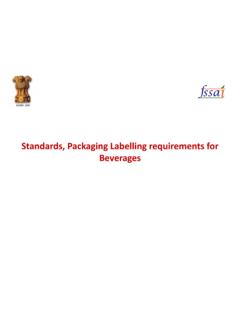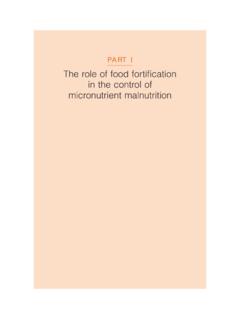Transcription of Dietary calcium and health - British Nutrition …
1 Blackwell Science, LtdOxford, UKNBUN utrition Bulletin1471-98272005 British Nutrition Foundation? 2005303237277 MiscellaneousDietary calcium and healthH. E. Theobald BR IE F IN G PA P E R. Dietary calcium and health H. E. Theobald British Nutrition Foundation, London, UK. SUMMARY. 1 INTRODUCTION. 2 SKELETAL FUNCTIONS OF calcium . Bone Bone growth Body calcium changes Fetal growth Pre-term infants Infancy Childhood and adolescence Attainment of peak bone mass Skeletal calcium changes in later life calcium and dental health 3 REGULATORY ROLE OF calcium . Introduction Intracellular calcium Role in blood clotting Role in digestion Role in neurological and muscular function 4 calcium HOMEOSTASIS AND METABOLISM.
2 Plasma calcium homeostasis Absorption Markers of calcium absorption and status Excretion Factors that influence urinary calcium excretion 5 Dietary REFERENCE VALUES. Dietary reference values Guidance on high intakes 6 SOURCES OF calcium IN THE DIET. Milk and dairy products Cereal products Plant foods Additional sources of calcium Correspondence: Dr Hannah Theobald, British Nutrition Foundation, 52 54 High Holborn, London WC1V 6RQ, UK. E-mail: 2005 British Nutrition Foundation Nutrition Bulletin, 30, 237 277 237. 238 H. E. Theobald 7 calcium INTAKE IN THE UK. Main Dietary sources Current intakes in the UK. Trends in intake 8 BIOAVAILABILITY OF calcium FROM FOODS. Dietary factors affecting calcium absorption Vitamin D.
3 Fat Protein Other Dietary factors Bioavailability from different Dietary sources Milk and milk products calcium from plants Other food sources 9 BONE calcium LOSS. Bone calcium loss Pregnancy and lactation Factors affecting age-related bone loss Osteoporosis Definition Public health implications Primary and secondary osteoporosis Dietary calcium , bone mass and age-related loss of bones Bone loss and calcium supplementation in early-post-menopausal women Bone loss and calcium supplementation in late-post-menopausal women Fracture risk 10 calcium IN health AND DISEASE. calcium and cancer calcium and cardiovascular disease calcium and weight management Hypercalcaemia calcium stone formation 11 CONCLUSIONS.
4 ACKNOWLEDGEMENTS. REFERENCES. Summary calcium is an essential nutrient as all living cells require calcium to remain viable;. calcium is also required for a number of specific roles in the body. The majority (~99%) of calcium present in the body is found in bone, with a smaller amount found in teeth. The remainder (<1%) is found in soft tissues and body fluids. The average adult skeleton contains 1200 g of calcium , present in the form of hydroxya- patite, an inorganic crystalline structure made up of calcium and phosphorus [Ca10(PO4)6(OH)2], which provides rigidity. calcium is essential for bone growth as it is required for the mineralisation (impregnation of the bone matrix with minerals). 2005 British Nutrition Foundation Nutrition Bulletin, 30, 237 277.
5 Dietary calcium and health 239. of bone; the rate of calcium deposition in bone is proportional to rate of growth. An adequate intake of calcium is one of a number of factors which are important for acquiring bone mass and attaining peak bone mass (PBM). Diets containing insuf- ficient amounts of calcium may lead to a low bone mineral density, which may have implications for bone health , notably risk of osteoporosis, in later life. As well as having a skeletal function, calcium plays a regulatory role in a number of specialised functions in the body. calcium plays a role in muscle (including car- diac muscle) contraction, neurotransmitter secretion, digestion and blood coagula- tion (clotting). calcium also plays a structural role outside of the skeleton, for example in organelles and membranes.
6 Disturbances in the structural and regula- tory roles of calcium can have implications for health and disease. For this reason, calcium homeostasis is tightly regulated to ensure that plasma concentrations of cal- cium ions are maintained within a set range ( mmol/L). Homeostasis is controlled at three main sites: the kidneys, bone and the gastrointestinal tract. Con- trol is mediated through the calciotropic hormones: parathyroid hormone (PTH), calcitriol and calcitonin. In response to changes in plasma calcium concentrations, absorption of calcium from the gastrointestinal tract can be altered, along with uri- nary excretion and calcium resorption from bone. The UK reference nutrient intake (RNI) for calcium for adults aged over 19 years is 700 mg/day; requirements are higher during childhood, adolescence and during lactation.
7 No guidance has been issued on high intakes, although exceeding an intake of 1500 mg calcium /day in the form of supplements is discouraged as this can cause stomach pain and diarrhoea. calcium intake appears to have increased over the last 30 years or so. On average, British men consume 1007 mg calcium /. day, whilst the average British woman consumes 777 mg/day (Henderson et al.), but intakes of calcium are a concern amongst certain groups of the population. For example, a high proportion of teenage boys and girls and women aged 19 24 years fail to meet the lower reference nutrient intake (LRNI) for calcium , their intakes are likely to be inadequate. A wide number of foods contain calcium , but the amount of calcium , provided per 100 g or per serving, and its bioavailability vary considerably.
8 The major source of calcium in British diets is milk and milk products (providing more than 40% of calcium intake amongst adults), followed by cereals and cereal products (providing 30% of intake). The contribution from cereals is high because although they are not a rich source, they are consumed in relatively large amounts and also some cereal products are fortified with calcium . For example, it is a mandatory requirement that white and brown wheat flours contain specified amounts of calcium , which is achieved through fortification. Additional sources of calcium include plant foods, including soya beans, some animal products ( eggs) and water. The bioavailabil- ity of calcium from a food is influenced by the presence of a number of other com- pounds within a food.
9 Dietary factors that influence absorption of calcium include fat (reduces absorption), protein and phosphorus (both increase absorption). The bioavailability of calcium from milk and milk products is in the region of 30% com- pared to 5% from spinach. Spinach, although containing a relatively large amount of calcium , is not considered a bioavailable source, as it contains a high concen- tration of oxalic acid which inhibits the absorption of calcium . Phytic acid and 2005 British Nutrition Foundation Nutrition Bulletin, 30, 237 277. 240 H. E. Theobald uronic acid, also found in plant foods, have a similar effect. However, the bioavail- ability of calcium from other plant foods is good, broccoli (see Bioavailability of calcium from foods).
10 Soya beans are also a notable exception, in that they contain high quantities of both oxalic and phytic acids, yet are a bioavailable source of cal- cium (bioavailability is in the region of 30 40%). The bioavailability of calcium from soya products will vary depending on the product. A low intake of calcium during growth has implications for bone mass, as the amount of calcium consumed in the diet influences the amount of calcium that can be retained by the skeleton during periods of growth. An inadequate intake of cal- cium combined with adequate energy and protein intakes may result in a low cal- cium content of bone, which may have implications for bone health later in life. The attainment of a high PBM in early adulthood is important as bone mineral (including calcium ) content starts to decline thereafter.









